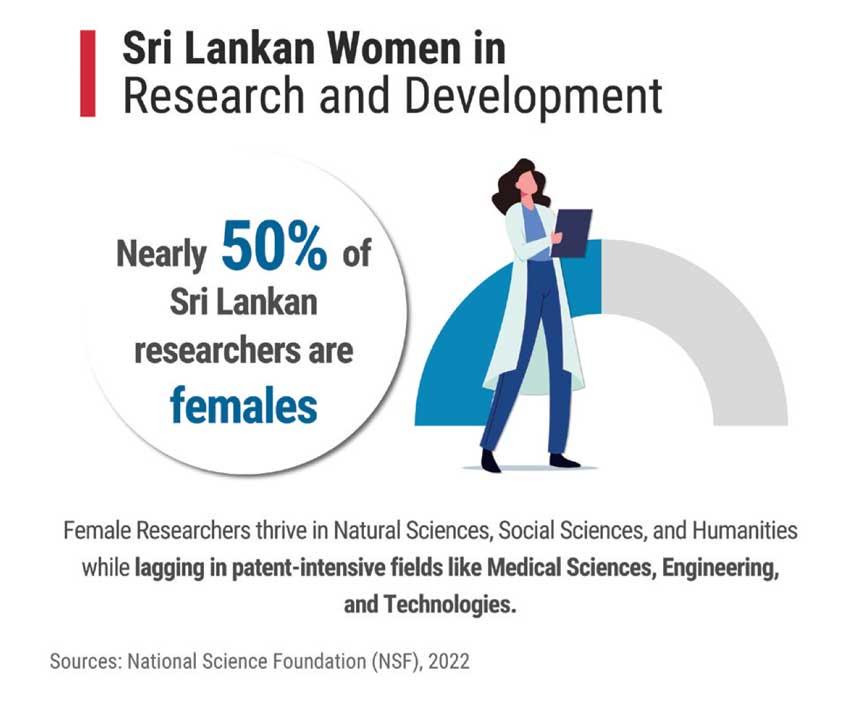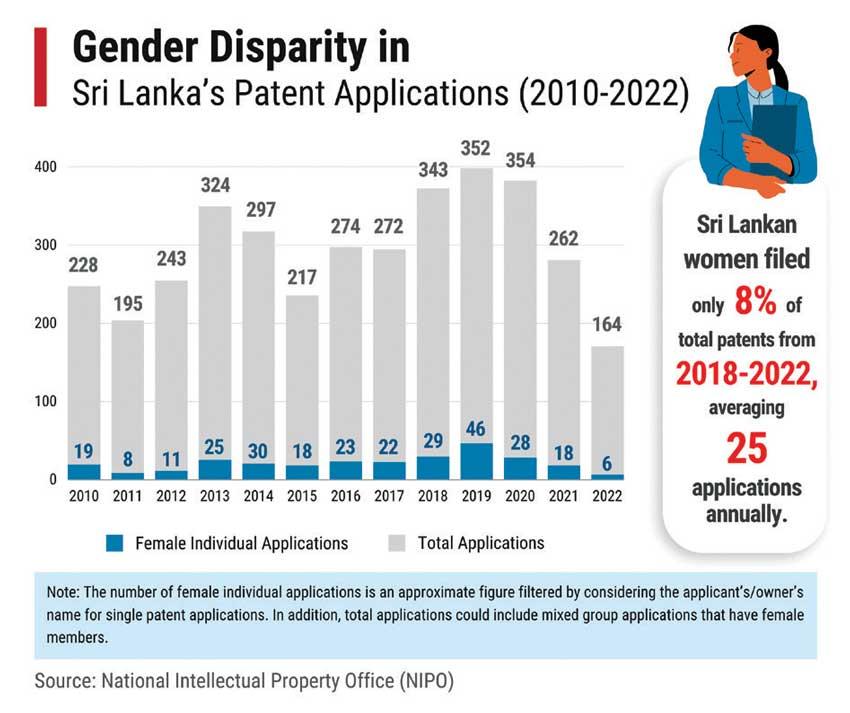27 Apr 2023 - {{hitsCtrl.values.hits}}

 “I do not intend to get a patent right for my invention as I do not want to disclose my research findings and methodologies to the public domain”, stated a female researcher who has discovered a solution for dengue fever.
“I do not intend to get a patent right for my invention as I do not want to disclose my research findings and methodologies to the public domain”, stated a female researcher who has discovered a solution for dengue fever.
Like her, many female innovators are unwilling to obtain Intellectual Property (IP) protection and commercialise their innovations for various reasons. One of the significant issues is theinsufficient understanding of Intellectual Property Rights (IPRs) and their application. Given that this year’s World IP Day, observed on April 26, focuses on “Women and IP: Accelerating Innovation and Creativity”,it is timely toexplore the state of women’s innovations in Sri Lanka and consider possiblestrategies to promote better IP protection for women’s creativity and innovations.
Women in Innovations
The number of patent applications issuedto women is a crucial and commonly used indicator to determine their involvement in innovation. However, Sri Lanka does not have gender-specific patent application data. Based on approximate calculations, the number of individual female patent applications fluctuated between 2010 and 2022, averaging nearly 25 patent applications per year inthe last five years (see infographic). This represents only 8 percent of the total patent applications during that period.
Globally, women’s patent applications are less than men’s; in 2020, nearly 16.5 percent of international patent applications were filed by women.Sri Lankan women appear to do poorly, especially compared to their Asian counterparts, where women’s applications represent 17.7 percent of total applications, with China and India leading the way.

Why are women’s innovations low in Sri Lanka?
Women’s involvement in research and development (R&D) activities,one of the key components of innovations, is at a satisfactorylevel in Sri Lanka. According to the National R&Dsurvey conducted by the National Science Foundation (NSF) in 2020, nearly 50 percent of researchers in the country are females. This figure is the highest percentage when compared with other South Asian countries. However, in total,the output indicators of R&D, such as the number of patents, journal publications, commercialisation, etc., are low in Sri Lanka. Further, the low number of female patents revealsthatmost women are involved in less patent-intensive fields, such as natural sciences, social sciences and humanities.Moreover, female researchers are uninterested in commercialising their inventions or using them for commercial purposes.There could be several reasons for this, such asa lack of awareness of IPRs and their importance, lack of incentives and institutional support for research commercialisation, and lack of targeted programmes to promote women’s innovations.
Science, technology, engineering, and mathematics (STEM) are the core fields of innovation. FemaleSTEM education in Sri Lanka is relatively good.According to the University Grant Commission (UGC) statistics, in 2017, women comprised 49 percent of undergraduate enrolments in STEM subjects in local universities.Yet very few women work or lead in STEM-related fields. This could be attributed to negative stereotypes surrounding girls’ competencies in subjects like mathematics, engineering, and information technology, as well as social, cultural, and gender norms.
Moreover, women’s participation in Sri Lanka’s creative industry sector is nearly 36 percent, with significant contributions in the product, graphic and fashion designand craft sectors. Nonetheless, the Creative and Cultural Industries in Sri Lanka reportreveals that women’s awareness of IPRs, even within the creative industry sector, is very minimal.
What needs to be done?
IPRs play a major role in encouraging innovation and creativity as they help to turn an idea/solution into a commercial opportunity. In Sri Lanka, there is clearly a need to encourage more female participation in patent-intensive R&D fields (such as medical sciences, engineering and technologies) and commercialisation.
‘Technology Transfer and Commercialization Units’ in universities and research institutes should collaborateeffectively with key stakeholder organisations such as the National Intellectual Property Office (NIPO), World Intellectual Property Office (WIPO), and the National Innovation Agency (NIA) to create awareness amongst women innovators andto support them in managing IP related commercial activities.
Furthermore, Sri Lanka can promote gender-inclusive innovation policies by introducing special programmes encouraging women’s participation in R&D activities and commercialisation, including national awards and incentive schemes in universities and research institutes.
Women’s participation in STEM fieldsand careers should be promoted by providing scholarships and introducing mentoring and development-oriented programmes. Furthermore, the importance of IPRs should be taught in secondary school and universitycurricula.This fact was highlighted by a young female inventor with more than 60 patent rights in Sri Lanka. She noted that“an inquisitive mind and a thirst for knowledge from school age have encouraged me to innovate. Creativity should be encouraged at the school level”.
It is of utmost importance to raise awareness and strengthen knowledge on access to IPRs amongst women innovators in Sri Lanka.This could be done byestablishing women-focused support networking systems, collaborations, learnings through selected role models, mentorship and funding programmes. Countries such as India (Women Scientists Scheme (WOS) by the Department of Science and Technology (DST)), Singapore (Women in Science (SgWIS) organisation), China, and South Korea have programmes and organisationstailored explicitly for women innovators.
Lastly, it is crucial to maintain an accurate and current database ofwomen’s patent applications at individual and group levels at the national database system of NIPO. Simple modifications to patent applications could facilitate this process. In addition, having such a databasewould be valuablein developing policies specific to women’s innovations.
(Dilani Hirimuthugodage is a Research Economist at IPS with research interests in Agriculture and Agribusiness Development, Environment, Natural Resources and Climate Change, and Intellectual Property. She holds a BA in Economics with a Second Class (Upper) and Masters in Economics (Distinction Pass) from the University of Colombo. In addition, she is a part-qualified candidate of CIMA-UK. Talk with Dilani: [email protected]).
22 Dec 2024 9 hours ago
22 Dec 2024 9 hours ago
22 Dec 2024 22 Dec 2024
22 Dec 2024 22 Dec 2024
22 Dec 2024 22 Dec 2024